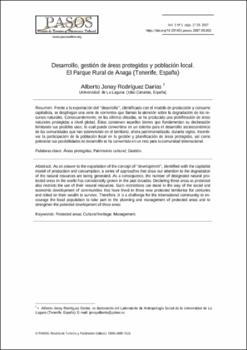Desarrollo, gestión de áreas protegidas y población local. El Parque Rural de Anaga (Tenerife, España)
Fecha
2007Resumen
Frente a la exportación del “desarrollo”, identificado con el modelo de producción y consumo
capitalista, se despliegan una serie de corrientes que llaman la atención sobre la degradación de los recursos
naturales. Consecuentemente, en las últimas décadas, se ha producido una proliferación de áreas
naturales protegidas a nivel global. Éstas conservan aquellos bienes que fundamentan su declaración
limitando sus posibles usos; lo cual puede convertirse en un estorbo para el desarrollo socioeconómico
de las comunidades que han sobrevivido en el territorio, ahora patrimonializado, durante siglos. Incentivar
la participación de la población local en la gestión y planificación de áreas protegidas, así como
potenciar sus posibilidades de desarrollo se ha convertido en un reto para la comunidad internacional. As an answer to the exportation of the concept of “development”, identified with the capitalist
model of production and consumption, a series of approaches that draw our attention to the degradation
of the natural resources are being generated. As a consequence, the number of designated natural protected
areas in the world has considerably grown in the past decades. Declaring these areas as protected
also restricts the use of their natural resources. Such restrictions can stand in the way of the social and
economic development of communities that have lived in these now protected territories for centuries
and relied on their wealth to survive. Therefore, it is a challenge for the international community to encourage
the local population to take part in the planning and management of protected areas and to
strengthen the potential development of these areas





